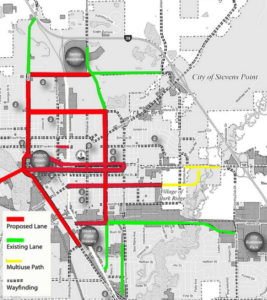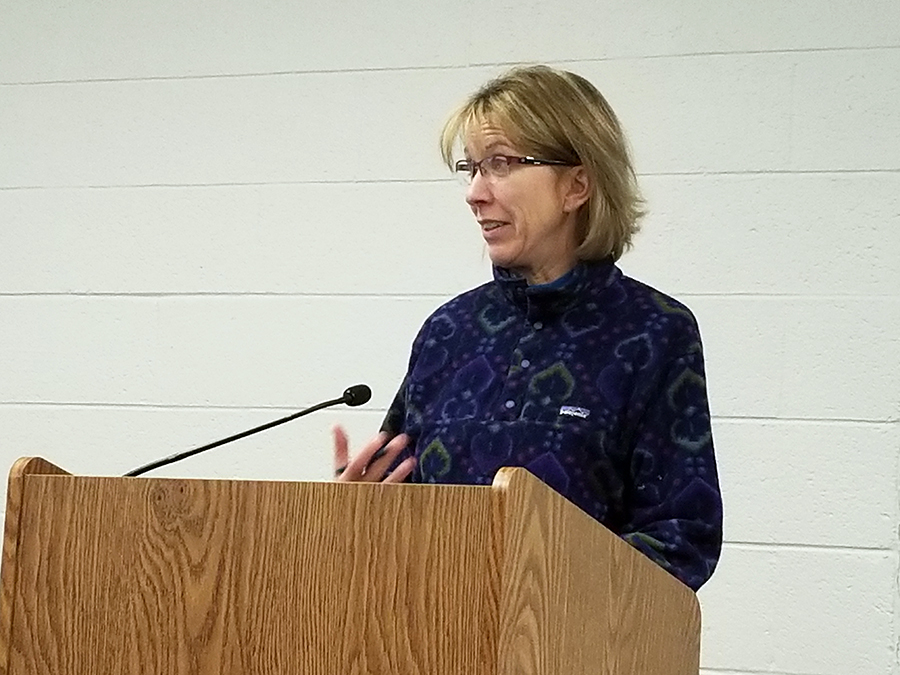Proposal on new bike commission to return in April
By Brandi Makuski
A vote on the proposed creation of a new bicycle safety commission has been postponed until April.
In a conversation lasting about 45 minutes on March 12, city leaders considered a request from Councilwoman Tori Jennings to replace the bicycle and pedestrian advisory committee (BPAC) with a five-member bicycle‐pedestrian street safety commission (BPSC). The new commission would be included in city ordinance, bringing to it a more formal standing, Jennings said.
Mayor Mike Wiza created BPAC shortly after being elected in 2015, saying he felt the city needed more input from bicycle enthusiasts, but said the committee was meant to be “advisory only” to the city plan commission.
Committee membership has also experienced higher turnover than other committees, Wiza said, and vacancies have been tough to fill.
In her memo to the public protection committee, Jennings argued the change was necessary because BPAC wasn’t taken seriously by the city, despite its multiple accomplishments.
Jennings played an integral role in the early days of BPAC, initially serving as its chair and helping spearhead an abandon bicycle ordinance. She also helped write a successful $400,000 federal Transportation Alternative Program (TAP) grant proposal, which will fund painting a network of almost 14 miles of bicycle lanes across the city—a cost the city must match by 20 percent.

“However, the notable success of BPAC obscures the ongoing challenges this committee faces in light of its ambiguous ‘citizen advisory’ status and lack of formal staff oversight,” Jennings’ memo read in part.
“I imagine one of the discussions that will be brought forward is the impact on staff time,” Jennings told the committee on March 12. “I just want to say that BPAC has been doing things that would require staff time…that includes grant writing, writing ordinances, bike-ped counts, bike friendly community status—all of these things, BPAC has been doing.”
She went on to say typically, city staff performs all the research on projects brought before council members, but, “BPAC is different; BPAC is doing all the work, all the research, everything.”
But Scott Beduhn, public works director, said the group has already taken “a lot of staff time”.
“The TAP grant alone took a fair amount of time,” he said. “Once we get into [painting bicycle lanes], it’ll take even more time. We already have a bike and pedestrian plan; it’s my job as city engineer to follow that plan.”
Beduhn said bicycle and pedestrian concerns promoted by BPAC often effect a public right-of-way; a piece of land containing underground utilities; or sometimes, privately-owned land—aspects which should be addressed by professional roadway engineers.
“I don’t really see a benefit to it,” he said. “We can’t replace solid engineering with another committee.”
When asked to estimate how much staff time might be necessary to assist the potential new commission, Michael Ostrowski, community development director, said he couldn’t be certain.
“I guess it really depends on what the goals and objectives are,” he said, adding he reached out to neighboring municipalities that already have a bicycle safety commission or similar body, and those communities averaged between 10 and 20 percent of staff time was devoted to the needs of their respective commissions. He also pointed out those municipalities had more personnel than Stevens Point.
Council President Meleesa Johnson said 17 percent of the city identified as being a bicyclist, and she didn’t believe they were being adequately represented. If BPAC were taken more seriously, she said, the group could assist in creating more progressive roadway designs before engineering plans were finalized.
“We’re not addressing, in a solid way, the need for a multi-modal transportation system,” she said. “BPAC has done some great things, but this isn’t just about bicycles, this isn’t just about sidewalks…this is about everybody using those corridors, and about us starting to think about using them differently. We’ve got a transportation commission, we’ve got an airport commission. My bicycle is very important to me, and I pay taxes. We’re missing the boat if we don’t start taking the time to do cross-disciplinary planning for our transportation corridors.”
Wiza argued the proposed ordinance was overly redundant.
“The only change I can see is, it’s perceived BPAC doesn’t have authority or is taken seriously,” he said. “I would beg to differ on that…putting it into an ordinance seems to be making a law were we don’t need a law.”
One troubling item contained within the proposed ordinance language, Wiza said, is the requirement that the new commission review all “public and private development plans and proposals for pedestrian and
bicycle facilities, and safe routes to schools”.
“BPAC already has the right and authority to look at projects now and make recommendations,” he said. “In some cases, those recommendations aren’t followed, but the same is true for any committee or commission; they are all advisory to the council. If this becomes a requirement under ordinance, that will make the process longer, potentially holding up any decision and potentially, it means we could lose out on certain developments or projects.”
Wiza said the proposed ordinance was not written by City Attorney Andrew Beveridge, although Beveridge did check the language submitted to him to ensure it was legally sound.
Some on the city council also had their doubts. Alderman Jeremy Slowinski said he didn’t understand how the new commission different from BPAC, and Councilman Mike Phillips suggested BPAC could potentially operate under the wing of the city’s transportation commission.
Councilwoman Heidi Oberstadt also said she wasn’t sure about making the change, citing concerns about additional workload for city staff.
“I’m not sure where it would go in the budget,” she added.
Ald. Cindy Nebel said she saw a “big difference” between the existing group and the one proposed, because BPAC “is not considered a committee that has any power.”
“I really have to say it doesn’t seem to have much power, like transit or public works,” Nebel said. “Everything we’re doing in our comprehensive plan is to make sure we’re walkable, green community. This would show we’re serious about making it a green city.”
BPAC member Trevor Roark argued the group has been inaccurately characterized by some media outlets as a group of lobbyists promoting personal agendas. He also cited concerns that department heads didn’t attend BPAC meetings, and some of the group’s ideas weren’t prioritized by city staff.
Becoming a formal commission, he reasoned, would allow their meetings to become part of the city’s video archives, so the community could better understand why their work is so important.
“Our city is falling short in serving the needs of its residents,” he said. “This is why BPAC exists, and the (the proposed commission) is the next step.”
Wiza suggested possible compromises, to include as making accommodating changes to BPAC, appointing a city council member to act as a liaison to the committee, or adding a member of BPAC to the city plan commission.
“We don’t have additional staff to do the things Mr. Roark said the [bike-pedestrian] committee doesn’t have time to do,” Wiza said.
The committee voted to postpone any action on the proposal until April, giving time for possible rewrites to the existing language proposal.


